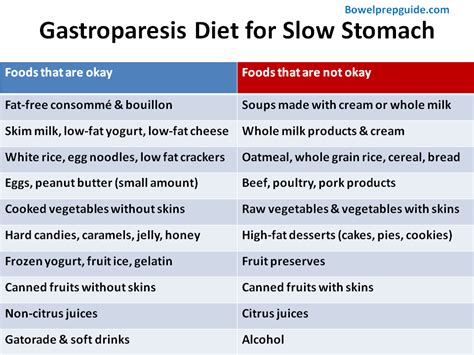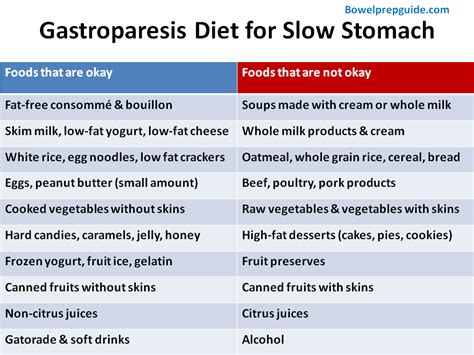

Are you suffering from gastroparesis? Learn about the best diet plan to ease your symptoms and improve your quality of life. Start feeling better today!
Gastroparesis is a condition that affects the stomach’s ability to empty food properly, causing symptoms such as nausea, vomiting, and bloating. For those who suffer from this condition, diet plays a crucial role in managing their symptoms. But what exactly should someone with gastroparesis be eating? Well, it’s not as simple as just avoiding certain foods. Instead, a gastroparesis diet involves making strategic choices about what to eat and when to eat it. Let’s take a closer look at some of the key components of a gastroparesis-friendly diet.
Daftar Isi
Introduction
Gastroparesis is a medical condition that affects the stomach’s ability to empty its contents properly. It causes symptoms such as nausea, vomiting, and abdominal discomfort. One way to manage gastroparesis is by following a specific diet. This article will discuss the gastroparesis diet and its benefits.
The Gastroparesis Diet
The gastroparesis diet aims to reduce the amount of fat and fiber in the diet. Fat slows down digestion, while fiber is difficult to digest. These foods can worsen symptoms for people with gastroparesis. Instead, the diet focuses on easy-to-digest foods that are low in fat and fiber.
Foods to Avoid
There are several foods that people with gastroparesis should avoid. These include high-fat foods, such as fried foods and fatty meats. They should also avoid foods that are high in fiber, such as whole grains, nuts, and seeds. Additionally, carbonated beverages and alcohol should be avoided.
Foods to Eat
The gastroparesis diet includes foods that are easy to digest, such as cooked fruits and vegetables, lean meats, and low-fat dairy products. Foods that are low in fiber, such as white bread and pasta, are also included in the diet. It is recommended to eat small, frequent meals throughout the day instead of large meals.
The Benefits of the Gastroparesis Diet
Following the gastroparesis diet can provide several benefits for people with gastroparesis. It can help reduce symptoms such as nausea and vomiting. The diet can also improve digestion and prevent complications such as malnutrition.
Reduced Symptoms
By avoiding high-fat and high-fiber foods, the gastroparesis diet can help reduce symptoms such as nausea, vomiting, and abdominal discomfort. Eating small, frequent meals throughout the day can also help prevent these symptoms.
Improved Digestion
The gastroparesis diet includes foods that are easy to digest, which can improve digestion in people with gastroparesis. By reducing the workload on the stomach, the diet can help the stomach empty its contents more efficiently.
Prevent Malnutrition
People with gastroparesis are at risk of malnutrition due to their inability to properly digest food. The gastroparesis diet includes nutrient-dense foods that are easily digestible, which can help prevent malnutrition.
Conclusion
The gastroparesis diet is an important part of managing symptoms and preventing complications for people with gastroparesis. By avoiding high-fat and high-fiber foods and eating small, frequent meals throughout the day, people with gastroparesis can improve their digestion and reduce symptoms. It is important to consult with a healthcare professional before starting any new diet or making significant changes to your current diet.
Understanding Gastroparesis: How Diet Can Help
Gastroparesis is a condition that affects the stomach’s ability to properly empty its contents into the small intestine. This can lead to a variety of uncomfortable symptoms such as bloating, nausea, and abdominal pain. While there is no definitive cure for this ailment, a balanced gastroparesis diet can help manage the symptoms. Here are some important things to keep in mind when it comes to eating with gastroparesis.
What Should You Eat?
When it comes to a gastroparesis diet, low-fat foods, lots of fiber, and lean proteins in small portions are key. Foods should be soft, cooked well, and easy to chew and digest. Some good examples include cooked vegetables, oatmeal, scrambled eggs, and baked chicken. It’s also important to eat slowly and take small bites to avoid overwhelming the digestive system.
Foods to Avoid
On the other hand, certain foods should be avoided as they can be particularly hard on the stomach. High-fat foods, spicy foods, and greasy foods are all culprits that can exacerbate symptoms. Carbonated drinks and high sugar foods should also be avoided. Instead, try incorporating fresh fruits and vegetables, whole grains, and lean proteins.
Eat Smaller Portions
Eating small, frequent meals throughout the day is recommended for patients with gastroparesis. This helps ease digestion and reduce symptoms such as bloating and stomach discomfort. Aim for 6 small meals per day instead of 3 large ones.
Incorporate Fiber
Soluble fiber is important in the gastroparesis diet since the stomach empties food slowly in this condition. Fruits, vegetables, and whole grains are good sources of soluble fiber. However, it’s important to avoid foods with high insoluble fiber content, such as raw fruits and vegetables, as they can be hard on the digestive system.
Hydration is Key
Patients with gastroparesis should drink plenty of water to prevent dehydration. However, be sure to avoid alcohol, which can slow down the digestive system. Drinking fluids between meals rather than with meals can also help ease symptoms.
Chew Food Thoroughly
Since digestion starts in the mouth, it is important to chew food well before swallowing. Chewing helps break down food into smaller pieces making it easier to digest. Avoid rushing through meals and take your time to thoroughly chew each bite.
Cook Foods Properly
Cooked foods are usually easier to digest than raw foods. Patients with gastroparesis are advised to cook their food well and avoid undercooked meats and eggs. This can help reduce the risk of bacterial infections that can further exacerbate symptoms.
Stick to Low-Fat Proteins
Proteins are an important part of the gastroparesis diet, but high-fat proteins such as red meats and dairy products should be avoided. Instead, focus on lean proteins such as chicken, fish or plant-based sources like tofu or legumes. These will be easier on the stomach and less likely to cause discomfort.
Seek Help from a Nutritionist
Seeking help from a nutritionist is beneficial for patients with gastroparesis. A nutritionist can create a customized diet plan that considers the patient’s individual needs and preferences. They can also help identify trigger foods and offer advice on how to modify meals to best manage symptoms.Overall, a balanced gastroparesis diet is key to managing symptoms and avoiding discomfort. By following these guidelines and seeking help from a nutritionist if needed, patients can take control of their condition and improve their quality of life.Gastroparesis Diet: Pros and ConsGastroparesis is a medical condition that affects the stomach, making it difficult to digest food. People with this condition often experience symptoms such as nausea, vomiting, bloating, and abdominal pain. To manage these symptoms, doctors often recommend a gastroparesis diet. Here are some pros and cons of following this diet:Pros:1. Helps manage symptoms: The gastroparesis diet is designed to help people with this condition manage their symptoms. By eating small, frequent meals and avoiding certain foods, people can reduce their nausea, vomiting, and other symptoms.2. Provides essential nutrients: Despite the restrictions, the gastroparesis diet still allows people to eat a variety of healthy foods. This ensures they get all the essential nutrients they need to maintain good health.3. Improves quality of life: By reducing symptoms, the gastroparesis diet can improve a person’s overall quality of life. They may be able to participate in more activities and enjoy a better sense of well-being.Cons:1. Restrictive: The gastroparesis diet can be very restrictive, which can make it difficult to follow. People may have trouble finding foods they enjoy and may feel limited in their choices.2. Social challenges: Following a restrictive diet can also make social situations challenging. Eating out or attending events may require careful planning and preparation.3. May lead to nutrient deficiencies: Despite the efforts to include a variety of foods, the gastroparesis diet may not provide enough of certain nutrients. This can lead to deficiencies over time.In conclusion, the gastroparesis diet can be an effective way to manage symptoms and improve quality of life for people with this condition. However, it is important to weigh the pros and cons and work closely with a doctor or dietitian to ensure all nutritional needs are met.
Gastroparesis is a condition that affects the normal movement of food through the digestive system. It’s a chronic condition that can cause nausea, vomiting, and abdominal pain. While there is no cure for gastroparesis, diet modification can help alleviate symptoms.
A gastroparesis diet involves eating foods that are easy to digest and low in fat and fiber. This means avoiding foods that are high in fat, fiber, and sugar, which can delay stomach emptying. Instead, focus on eating small, frequent meals throughout the day. Choose foods that are easy to digest, such as lean protein, cooked vegetables, and fruits without skins.
If you have gastroparesis, it’s important to work with a registered dietitian to develop a customized meal plan that meets your individual needs. In addition to modifying your diet, there are other lifestyle changes you can make to manage your symptoms. This may include eating slowly, chewing your food thoroughly, and avoiding carbonated drinks and alcohol.
While gastroparesis can be a challenging condition to manage, following a gastroparesis diet can help you feel better and improve your quality of life. If you’re struggling with symptoms of gastroparesis, talk to your doctor about developing a treatment plan that works for you.
Video gastroparesis diet
Visit VideoGastroparesis is a medical condition that affects the normal movement of food through the digestive system. It can lead to symptoms such as nausea, vomiting, and abdominal pain. People who have gastroparesis often wonder about the right diet to follow to manage their symptoms. Here are some common questions people ask about gastroparesis diet:1. What foods should I avoid if I have gastroparesis?
There are certain foods that can aggravate gastroparesis symptoms, including:
- High-fat foods
- Fried foods
- Spicy foods
- Raw fruits and vegetables
- Carbonated drinks
- Alcohol
2. What foods are good for gastroparesis?
While there isn’t a specific gastroparesis diet, there are some foods that can help manage symptoms:
- Low-fat foods
- Cooked fruits and vegetables
- Mashed potatoes
- Smoothies
- Soups
- Lean proteins
3. Should I eat smaller meals more frequently?
Yes, eating smaller, more frequent meals can help manage gastroparesis symptoms. Try to eat 5-6 small meals throughout the day instead of 3 large meals.
4. Can supplements help with gastroparesis?
Some people find relief from gastroparesis symptoms by taking supplements such as probiotics, digestive enzymes, and fiber supplements. However, it’s important to talk to your doctor before taking any supplements.
5. Is there anything else I can do to manage my symptoms?
In addition to following a gastroparesis-friendly diet, there are some lifestyle changes you can make to manage your symptoms:
- Chew your food thoroughly
- Drink plenty of water
- Avoid lying down after eating
- Stay active and exercise regularly
- Manage stress levels
By making these dietary and lifestyle changes, people with gastroparesis can manage their symptoms and improve their quality of life. However, it’s important to talk to a healthcare professional before making any major changes to your diet or lifestyle.






